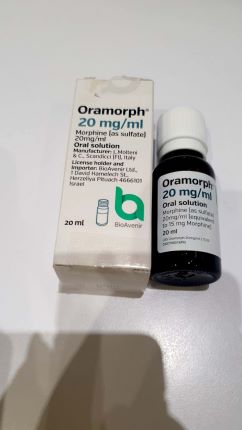Quest for the right Drug

אורמורפ 20 מ"ג / מ"ל ORAMORPH 20 MG/ML (MORPHINE AS SULFATE)
תרופה במרשם
תרופה בסל
נרקוטיקה
ציטוטוקסיקה
צורת מתן:
פומי : PER OS
צורת מינון:
תמיסה (פומי) : SOLUTION (ORAL)
עלון לרופא
מינוניםPosology התוויות
Indications תופעות לוואי
Adverse reactions התוויות נגד
Contraindications אינטראקציות
Interactions מינון יתר
Overdose הריון/הנקה
Pregnancy & Lactation אוכלוסיות מיוחדות
Special populations תכונות פרמקולוגיות
Pharmacological properties מידע רוקחי
Pharmaceutical particulars אזהרת שימוש
Special Warning עלון לרופא
Physicians Leaflet
Overdose : מינון יתר
4.8 Overdose Symptoms of intoxication The sensitivity towards morphine varies greatly from patient to patient. Therefore, symptoms of intoxication can occur in adults after application of single doses which correspond to a subcutaneous and intravenous dose of about 30 mg. In patients with carcinoma these doses are frequently exceeded without provoking serious adverse reactions. The manifestation of an opioid intoxication comprises the triad of miosis, respiratory depression and coma. At first pinpoint pupils are observed; however, in case of marked hypoxia the pupils are dilated. Respiration is markedly reduced (breath rate of 2-4 per minute). The patient becomes cyanotic. Morphine overdosage leads to giddiness and stupor up to coma. The blood pressure remains normal initially, but decreases markedly with progression of intoxication. Persistent decrease in blood pressure can result in shock. Tachycardia, bradycardia and rhabdomyolysis can occur. The body temperature decreases. The skeletal muscles relax; occasionally generalised seizures can develop, especially in children. Death may occur from respiratory failure. Death occurs mostly due to respiratory insufficiency or due to complications such as pulmonary oedema. Aspiration pneumonia can develop. Therapy of intoxication In unconscious patients with respiratory arrest ventilation, intubation and intravenous administration of opioid antagonists (e. g. 0.4 mg naloxone intravenously) are indicated. In case of persistent respiratory insufficiency the single dose has to be repeated 1 to 3 times in 3-minute intervals until the respiratory rate is back to normal and the patient responds to painful stimuli. The patient has to be strictly monitored (at least for 24 hours) since the duration of action of the opioid antagonist is shorter compared to that of morphine so that recurrence of the respiratory insufficiency has to be expected. The single dose of the opioid antagonist is 0.01 mg per kg body weight in children. Additionally measures to prevent a decrease in body temperature and to supplement volume may be necessary.

מסגרת הכללה בסל
התוויות הכלולות במסגרת הסל
| התוויה | תאריך הכללה | תחום קליני | Class Effect | מצב מחלה |
|---|---|---|---|---|
| MORPHINE | ||||
| HYDROMORPHONE | ||||
| For the relief of severe pain in cancer. |
שימוש לפי פנקס קופ''ח כללית 1994
לא צוין
תאריך הכללה מקורי בסל
לא צוין
הגבלות
לא צוין
מידע נוסף
